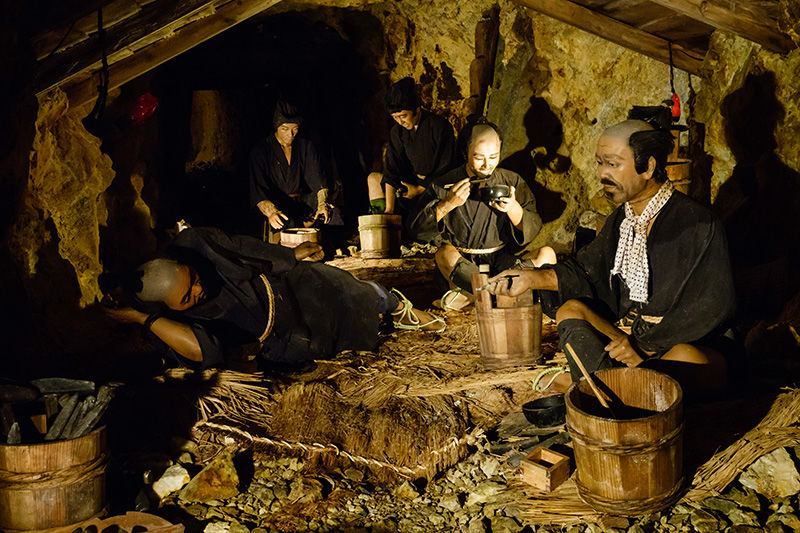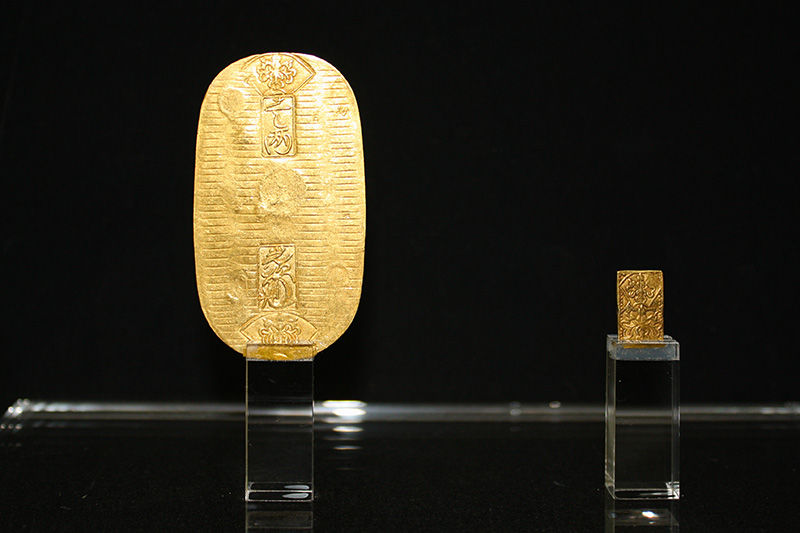
The Shōgun’s Golden Mountain: A Tour of Japan’s Sado Kinzan Mine
Guideto Japan
Culture- English
- 日本語
- 简体字
- 繁體字
- Français
- Español
- العربية
- Русский
Sado’s Golden Shores
Sado has long been associated with shining riches. The Konjaku monogatari (trans. Japanese Tales from Times Past), a collection of fanciful stories from the twelfth century, tells about a miner from Noto province who traveled to Sado and returned with piles of gold. The celebrated nō playwright Zeami also alluded to Sado’s gilded past in his work Kintōsho (The Book of the Golden Island) that recounts his exile there in 1434.
 Mount Toramaru at the historic Nishimikawa gold mine (left) and the entrance of the Ōtakimabu tunnel at the Tsurushi silver mine (right). These sites predate the Sado kinzan.
Mount Toramaru at the historic Nishimikawa gold mine (left) and the entrance of the Ōtakimabu tunnel at the Tsurushi silver mine (right). These sites predate the Sado kinzan.
Although these literary works show that gold excavation had been underway for some time, the first recorded mining operation on Sado was in 1460 at the Nishimikawa mine. Early miners primarily worked sedimentary deposits, sifting through tons of rock and soil in search of gold flakes and nuggets. The discovery of the Tsurushi silver mine in 1542, however, prompted mine administrators to develop new techniques to exploit the site’s rich mineral veins.
Following the discovery of the Sado kinzan mine in 1601, workers rapidly put these new technologies to use in developing the site. The mine’s opening focused attention on the island and drastically altered Sado’s history.
 The split mountain top of the kinzan gold mine attests to the intensity with which the site was exploited. The man-made crevice measures 30 meters across and 74 meters deep.
The split mountain top of the kinzan gold mine attests to the intensity with which the site was exploited. The man-made crevice measures 30 meters across and 74 meters deep.
A Mining Town is Born
Word of the kinzan mine quickly reached Shōgun Tokugawa Ieyasu (1543–1616), who promptly dispatched a representative to Sado. Early work centered on silver production, and in 1602 the island’s magistrate sent Ieyasu 10,000 kan of the precious metal, an amount roughly equivalent to ¥20 billion today. In the first part of the seventeenth century 40 tons of silver were excavated from the kinzan annually, making it in its day one of the world’s richest silver mines. The mountain eventually came to be strongly associated with gold production, though, producing over the same period an average of 400 kilograms a year.
 A reproduction of the magistrate’s headquarters on Sado near the kinzan.
A reproduction of the magistrate’s headquarters on Sado near the kinzan.
In 1603 Ieyasu placed Sado under direct control of the central government and appointed Ōkubo Nagayasu (1545–1613), a trusted administrator who had experience running mines, as regional governor. As excavation at the kinzan expanded, the subsequent inflow of workers and other people had a dramatic effect on Aikawa, which sets at the foot of the mountain.
In a very short span Aikawa transformed from a sleepy outpost of fewer than 20 buildings to a bustling mining town of 50,000 people. Only half of the four square kilometers of land comprising the village was open to habitation, though, and residents had to make the most of what space was available. The solution for many was to build vertically, and it is said that several three-story buildings, rarities at the time, could be seen towering above Aikawa’s narrow streets. Records from this period describe a community buzzing with prosperity. One account even goes so far as to compare the liveliness of the town’s central Kyōmachi district to the gaiety of Kyoto.
 The Sado Kinzan Museum offers visitors a glimpse at Aikawa’s lively past.
The Sado Kinzan Museum offers visitors a glimpse at Aikawa’s lively past.
Criminals and Refugees
Sado has long been known as a destination for political exiles. Famous outcasts include Zeami as well as the influential Buddhist priest Nichiren and Retired Emperor Juntoku. However, it is equally infamous as the last stop of hordes of convicts, drifters, and other social outcasts, broadly referred to as mushukunin, who were sent to toil in the gold mine. But Nabata Shō, an employee of the company Golden Sado, which manages the kinzan site, refutes the common image that mushukunin were ne’er-do-wells, pointing out that refugees also made up a considerable portion of this group.
“There were mostly skilled mineworkers along with some mushukunin who provided manual labor,” he explains. “But not every person pressed into service was a criminal or vagrant. Around the middle of the Edo period [1603–1868] natural disasters and famine forced large numbers of people off their land in the provinces. With nowhere to go, many of these refugees found their way to Edo and other urban centers on Japan’s main islands. The bakufu considered them a threat to public safety, and with few options at hand, they rounded many of them up and shipped them off to the kinzan.”
 A display shows mineworkers inside the Sōdayū tunnel taking a break. Minework could be lucrative for skilled laborers.
A display shows mineworkers inside the Sōdayū tunnel taking a break. Minework could be lucrative for skilled laborers.
This policy coincided with the emergence of a dire labor shortage at the mine as tunnels grew deeper. Early excavation exploited deposits of gold and silver close to the surface. But as these were depleted miners dug further underground, and by the 1690s tunnels extended far enough down that they needed specialized laborers to remove groundwater and keep the mine shafts from flooding.
 A display shows the snaking tunnels miners carved through the mountain in pursuit of gold and silver.
A display shows the snaking tunnels miners carved through the mountain in pursuit of gold and silver.
Administrators initially employed men from local villages to pump the mines, paying them high wages for the backbreaking work. However, as tunnels grew deeper and the work more perilous, it became increasingly difficult to secure enough hands to keep minework moving along smoothly. By sending Edo’s burgeoning population of mushukunin to Sado, the central government was able to address two problems at once.
Nabata says that while social outcasts being rounded up and sent into the mine remains a popular perception among people, it does not accurately reflect life at the kinzan. “When the mine was at its peak, Aikawa supported a population of 50,000,” he explains. “Most workers were townspeople or skilled laborers. During the Edo period only 1,874 mushukunin were put to work in the mines.”
 Hand-cranked screw pumps were used to bring water out of the mine shafts.
Hand-cranked screw pumps were used to bring water out of the mine shafts.
A Wealth of Gold and Silver
The kinzan mine was a self-contained operation. Each stage, from ore processing to the minting of coins, was conducted onsite. The riches that flowed from the mine during the Edo period helped finance the Tokugawa shogunate and kept the regime self-sufficient in gold and silver.
 A gold koban coin (left) and ichibu ingot. (Photo courtesy of Golden Sado)
A gold koban coin (left) and ichibu ingot. (Photo courtesy of Golden Sado)
After the Tokugawa regime fell, the new Meiji government took over mine operations. It brought in foreign engineers and adopted Western technologies in a bid to boost flagging productivity. In 1896 it sold the mine to the Mitsubishi conglomerate, which continued to mechanize the extraction process. Production reached a pinnacle around 1940, helping fund Japan’s wartime ambitions. The mine was finally closed in 1989 after 388 years.
 The mine’s 50-meter-wide thickener was built in 1940 to separate tailings and water.
The mine’s 50-meter-wide thickener was built in 1940 to separate tailings and water.
The vein of gold running through the kinzan measures a mere 3 kilometers east to west and 600 meters north to south, reaching a depth of 800 meters. Over nearly four centuries miners bore more than 400 kilometers of tunnels into the mountain, about twice the circumference of Sado, and extracted an impressive 15 million tons, equivalent to a cube 180 meters on each side, of stone.
 The Dōyū tunnel was excavated from the end of the Meiji era (1868–1912) until the mine was closed.
The Dōyū tunnel was excavated from the end of the Meiji era (1868–1912) until the mine was closed.
According to Nabata it took an average of 1 ton of ore to produce 5 grams of gold, and that around 78 tons of gold and 2,330 tons of silver were extracted over the lifetime of the mine. In 1997 the Hishikari mine in Kagoshima Prefecture surpassed Sado’s kinzan in terms of gold production, but the mountain retains its title as Japan’s richest silver mine.
 Golden Sado employee Nabata Shō stands at the entrance of an old mining tunnel.
Golden Sado employee Nabata Shō stands at the entrance of an old mining tunnel.
Campaign for Heritage Status
The Sado kinzan mine holds a unique place in Japanese history for its pivotal role in helping finance the government from feudal times all the way to the modern age. In recognition of its historical importance, there is now a campaign underway to have it registered as a UNESCO World Heritage Site.
 The Sado Kinzan Museum preserves mining machinery used from the Meiji era onward.
The Sado Kinzan Museum preserves mining machinery used from the Meiji era onward.
The petition includes the Sado kinzan, the Nishimikawa gold mine, and the Tsurushi silver mine. These sites provide an important historical and cultural record of Japan’s mining history stretching back more than five centuries that includes advances in operation and excavation techniques and the lifestyles of people who depended on the mines for their livelihood.
 Operating from the nineteenth century to the early twentieth century, the Kitazawa floatation plant—a facility for separating precious metal from raw ore—boasted the largest capacity in East Asia.
Operating from the nineteenth century to the early twentieth century, the Kitazawa floatation plant—a facility for separating precious metal from raw ore—boasted the largest capacity in East Asia.
Sado Kinzan Gold Mine
- Location: Shimoaikawa 1305, Sado, Niigata Prefecture
- Tel: 0259-74-2389 (Japanese)
- Hours: 8:00–17:30 (April–October), 8:30–17:00 (November–March), open year round
- Admission: Edo course (Sōdayū tunnel) and Meiji course (Dōyū tunnel), ¥900 for either or ¥1,400 for both (half price for children; group prices available)
- Website: http://www.sado-kinzan.com/en/
 Entrance to the Sado Kinzan Gold Mine.
Entrance to the Sado Kinzan Gold Mine.
(Originally written in Japanese by Aoki Yasuhiro and published on December 22, 2017. Banner photo: The Kitazawa floatation plant. Photos by Miwa Noriaki except where noted.)